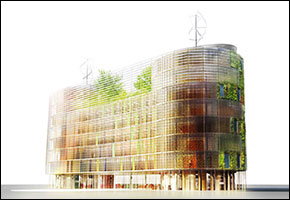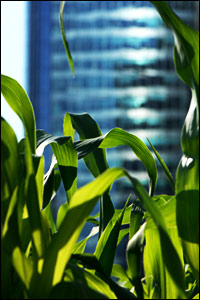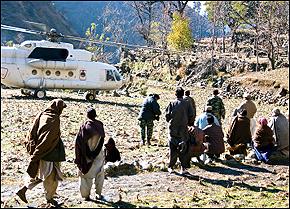Rethinking cities: Moving the farm indoors
Vertical farms: Reclaiming urban space and moving production closer to consumption
by C.T. Pope
Circle of Blue
Imagine a city as a black hole where all matter is sucked in and disappears — nothing is produced and everything is consumed. It was from this perspective that Columbia University Professor Dickson Despommier explained his revolutionary idea of “vertical farming” to me. This seemingly simple concept brings food production into the city center, where farms are stacked in skyscrapers and powered by renewable resources and the city’s own waste stream. It’s what he calls an ecological solution to the consumer-centric “black hole” model of the modern city.
“Nothing that we’ve done, either in the city or outside the city, has reflected ecological processes and as a result we find ourselves in a bind,” he said during a phone interview. “As we continue to grow, we consume more food, and as our food stocks diminish, we cultivate more land…the world farms the equivalent of the continent of South America, which is a huge land mass,” he continued, “and these farms consume more than 70 percent of the world’s fresh water.”
His solution: renewable, sustainable, local, urban, vertical farming
The idea was not born out of hopes of saving the planet, he admits. “It’s certainly not a Utopian idea,” Despommier explained, “the vertical farm concept is a supplement to rural situations that still function normally.” Originally the concept came about as simple solution to reduce disease transmission and reclaim the abandoned apartment buildings and open lots of New York City. Graduate students in his medical ecology class helped pioneer the concept back in 1999. Since then, Despommier has refined his model into the vertical farm and garnered the attention of city planners from Portland to Dubai.
The vision has been called crazy by some: a “zucchini-in-the-sky concept,” according to the New York Times. But at its base it’s technologically simple: it uses already developed indoor farming techniques, like hydroponics and aeroponics, and modern architectural ideas. “It’s like a box of Lego,” he explained, “each piece is a little bit different…but the moment you put them together in a unique fashion, you’ve got something brand new that you could never imagine otherwise.”
The concept emphasizes local renewable energy sources and allows the architect to create different designs dependent upon the available space. Despommier’s visions are as unique as the concept itself: long, thin, five-story buildings snaking their way through the deserts of the Middle East and southwest America, mostly solar-powered; tall, windowless buildings in Greenland and New Zealand, powered by geothermal energy; and elegant glass skyscrapers off the coast of Chicago or downtown New York — powered by a combination of wind, solar, and reclaimed incinerated city waste. New York’s farms could even be powered by tidal energy generated in the Hudson River. The sky is quite literally the limit.
Food production and water reclamation?
In all his models, Despommier emphasizes both renewable energy and reclaimed water. In present day hydroponics farms outside of Phoenix, for example, water use is about 90 percent less than in traditional farms. Why? Because traditional outdoor farming loses thousands of gallons of water daily to runoff, evaporation, and transpiration — water “breathed out” by the plant’s leaves. Indoors all this water is captured and reused. The end result is closed system, where the only water leaving is the water in the produce itself. Even greywater could be used in these urban settings, a practice already common in water stressed regions. The end result: not only would the farms produce the city’s food, but they also could serve as water reclamation facilities.
While the concept still needs developing, small-scale studies have already shown some promise. In one scenario, Despommier described a project that modeled a farm in an abandoned Chicago warehouse. Though requiring some $122 million in startup costs, the farm would produce enough food to feed 14,000 people and reclaim its costs in four to five years. In Seattle, the recent Cascadia Region Green Building Council’s Living Building Challenge gave the “best of show” award to a vertical farm designed by Mithun architects, which incorporated both a living space for residents and an urban farm. Moving from drawing board to construction has proved difficult though.
“What needs to happen…is for some municipality or some country to step up and say ‘we want you to design the first one for us’ and with an influx of about $3 million I can assemble a team of experts…but until that money shows up, it remains a theoretical construct,” Despommier said. While planners in cities like Abu Dhabi and Las Vegas are taking the idea seriously, it remains unclear when the first urban vertical farm will open.
C. T. Pope is a Circle of Blue staff writer and researcher. Reach him at circleofblue.org/contact.
Circle of Blue’s east coast correspondent based in New York. He specializes on water conflict and the water-food-energy nexus. He previously worked as a political risk analyst covering equatorial Africa’s energy sector, and sustainable development in sub-Saharan Africa. Contact: Cody.Pope@circleofblue.org










Intensive farming (including vertical farming) is the future, however it is a big challenge. One solution is to compartmentalize the problem. Food comes in multiple categories: dry grains, high-water-content fruits and vegetables, herbs and spices, tropical oils, milk and eggs, legumes, and meat and poultry and fish.
Dry grains and tropical oils are the hardest problem and may never be suitable for intensive farming.
Fruit and vegetables and herbs and spices are ideal for intensive farming. A acre of land can provide for hundreds of people.
Eggs are ideal for city farming. Hens can easily be managed by amateur farmers and enjoy a more humane life. Disease requires close contact, so only the breeding needs to be done be licensed companies.
Legumes are a tricky problem. They should probably be grown in soil, since they improve soil. Peas are good, and accepted by the Western palate.
Farming of the future should place a high premium on land, sunlight, water, and nutrients. Special care should be taken to preserve phosphorus reserves. This means using organic farming whenever possible and appropriate.
The American emphasis on corn and soy to the exclusion of all else is hugely damaging to the environment.
Eventually people will need to eat smaller steaks. One solution is shrimp paste. Small shrimp are very efficient at converting food to body mass.
Outdoor vertical farming holds promise in the higher latitudes. Lightweight planters, soil or hydroponic, could be suspended from cables running East-West.